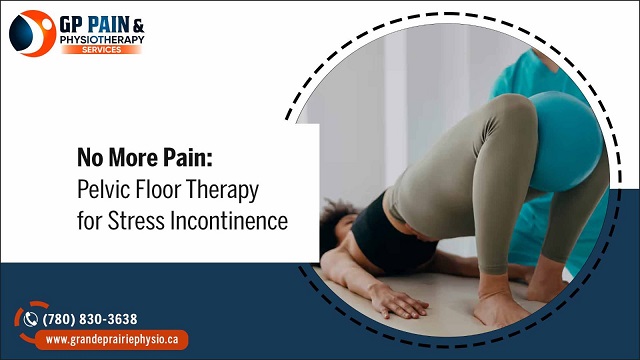Stress incontinence can be frustrating and often embarrassing, affecting confidence and daily routine. Those little leaks—can make life much less enjoyable. But don’t worry—there’s hope! Pelvic floor physiotherapy in Grande Prairie is a game-changing solution that helps individuals regain control and ditch discomfort.
What Is Stress Incontinence?
Stress incontinence is a urinary incontinence where physical pressure or stress on the bladder leads to unintentional urine leakage. Unlike urge incontinence, which involves a sudden, strong need to urinate, stress incontinence is triggered by activities like:
- Sneezing or coughing.
- Laughing or yelling.
- Exercising, especially running or jumping.
- Lifting heavy objects.
This condition often arises when the pelvic floor muscles and connective tissues are weakened or stretched, compromising their ability to support the bladder and urethra.
Common Causes of Stress Incontinence
Stress incontinence doesn’t develop overnight. It often stems from a combination of factors that can weaken the pelvic floor over time, such as:
1. Childbirth: The strain on the pelvic floor during pregnancy and delivery can lead to muscle weakness or damage, making it harder to control bladder function.
2. Hormonal Changes: During menopause, lower estrogen levels may affect the strength and elasticity of pelvic tissues, increasing the risk of incontinence.
3. Surgery: Procedures like prostate or hysterectomy surgeries can disrupt pelvic floor integrity, leading to stress incontinence.
4. Aging: Over time, natural wear and tear on the pelvic floor muscles may also contribute to stress incontinence.
How Does Stress Incontinence Impact Daily Life?
Stress incontinence can affect individuals’ lives in ways that go beyond physical symptoms. Many people struggle with:
- Social Anxiety: Fear of leaks in public settings.
- Activity Avoidance: Skipping workouts or physical activities.
- Clothing Restrictions: Wearing dark or oversized clothes to hide leaks.
- Emotional Distress: Feelings of embarrassment or frustration.
Left untreated, stress incontinence can lead to a significant decline in quality of life, but it doesn’t have to be permanent.
How Pelvic Floor Therapy Helps with Stress Incontinence
Pelvic floor physiotherapy in Grande Prairie is a multifaceted approach designed to strengthen and heal the pelvic muscles responsible for bladder control. Below, we explain the actionable steps for effectively performing it.
1. Targeted Strengthening: Building a Strong Foundation to Combat Stress Incontinence
For stress incontinence, targeted strengthening is vital. Kegel exercises are the most common technique to strengthen the pelvic floor muscles. To perform a Kegel, start by sitting or lying comfortably. Focus on tightening the muscles individuals would use to stop urination midstream (make sure not to do this while urinating). Hold the contraction for about 3 to 5 seconds, then relax simultaneously. Repeat this process for three sets of 10 repetitions each day. When performed correctly, these exercises help restore strength to the pelvic floor and can significantly improve bladder control in individuals with stress incontinence.
2. Muscle Coordination: Teaching the Pelvic Floor to React to Stress Incontinence Triggers
In addition to strengthening, muscle coordination is key to preventing stress incontinence. One effective technique is called “The Knack.” To perform this exercise, tighten the individual’s pelvic floor muscles just before engaging in an activity that may trigger incontinence, such as sneezing, coughing, or lifting. Hold the contraction for a few seconds before releasing. By practicing this in anticipation of such activities, individuals’s pelvic muscles will be trained to respond reflexively, preventing leaks. Repeating this exercise helps create an automatic response that reduces the likelihood of stress incontinence episodes.
3. Tissue Recovery: Restoring Mobility to the Pelvic Floor
Stress incontinence may result from scar tissue or tension in the pelvic floor, often caused by childbirth or surgery. Tissue recovery exercises help restore mobility and flexibility. One common technique physiotherapists use is manual therapy, where gentle massage is applied to the pelvic area to release tightness and improve function.
At home, pelvic stretches such as butterfly stretches can complement manual therapy. To perform this stretch, first, sit on the floor with the soles of the individual and gently press the individual’s knees toward the floor. Hold for 20–30 seconds and repeat three times. This helps release tension and enhances the flexibility of the pelvic tissues, reducing the risk of stress incontinence.
4. Bladder Training: Improving Control and Reducing Leaks
Bladder training is an essential aspect of managing stress incontinence. This technique involves extending the time between bathroom visits to hold more urine. Start by tracking individuals’ bathroom habits for a few days to understand individuals’s baseline. Then, gradually try to delay bathroom trips by 5–10 minutes, slowly increasing the interval until individuals can comfortably hold their bladder for 2–4 hours. Along with strengthening exercises, bladder training helps increase bladder capacity, reduces urgency, and ultimately aids in managing stress incontinence.
Benefits of Utilizing Pelvic Wall Therapy
- Improved Bladder Control: Say goodbye to those “uh-oh” moments with stronger muscles that support better control.
- Non-Surgical Solution: Avoid invasive procedures with this natural and practical approach.
- Pain Reduction: Address any discomfort caused by muscle tension or misalignment.
Tips to Manage Stress Incontinence Alongside Therapy
While pelvic health physiotherapy works to resolve the root causes of stress incontinence, these tips can help individuals manage symptoms in the meantime:
- Avoid Bladder Irritants: Avoid caffeine, alcohol, and spicy foods.
- Wear Protective Liners: Confidence comes with feeling prepared. Use discreet liners if needed.
- Maintain a Healthy Weight: Excess weight can place additional pressure on individuals’ pelvic floor.
Take Control of Stress Incontinence Today
Pelvic floor physiotherapy in Grande Prairie provides a proven path to effectively managing and reducing stress incontinence symptoms. By incorporating our training into an individual’s routine, they can take significant steps toward regaining bladder control and reducing leaks. GP Pain Physiotherapy in Grande Prairie is here to help. Contact us today to schedule an individual’s personalized pelvic floor therapy program. Then, start an individual’s journey to a life free from the challenges of stress incontinence with our physiotherapy clinic.


